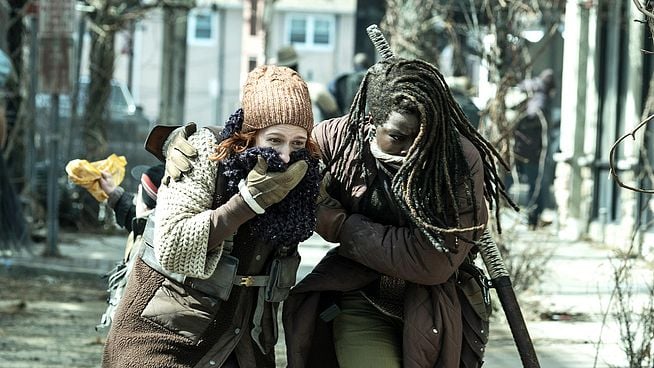
The first two episodes of the latest “The Walking Dead” spin-off “The Ones Who Live” don’t skimp on intense scenes. The recently released second episode features a particularly shocking scene. In her search for her true love, Rick (Andrew Lincoln) Michonne (Danai Gurira) has just found new allies in a splinter group of a nomadic society who, with their support, give her new hope. Almost all of her new comrades in arms are taken from her in a particularly brutal manner.
As the troops walk through the streets of a city, they are spotted by a CRM helicopter – which doesn’t hesitate long and gas-bombs the people on the ground. This is yellow-green chlorine gas, which quickly kills many who are exposed here. If ‘The Walking Dead’ evokes brutal methods of war where simply breathing leads to death, the zombie franchise provides particularly chilling moments that haven’t been seen there in a long time. But is the effect of chlorine gas really as deadly as depicted here?
Chlorine gas as a chemical weapon
The fact that chlorine gas is indeed poisonous was first used in warfare during World War I. Because it is more dense than air, it collects at the bottom of poorly ventilated areas, such as the many trenches during conflict. The result was many deaths and even more soldiers suffering long-term injuries. In fact, the symptoms of chlorine gas poisoning were depicted quite accurately in “The Walking Dead: The Ones Who Live.”
After inhalation, the eyes, skin and respiratory tract are affected, resulting in severe coughing. However, to achieve a lethal effect, large amounts of chlorine gas are requiredThat is why chemical warfare – as treacherous as it unfortunately sounds – later used more deadly gases such as phosgene or mustard gas, even though chlorine gas attacks still occur today due to its relatively easy availability.
Preparation already in “The Walking Dead: World Beyond”
That the chlorine gas in “The Walking Dead: Those Who Live“Now it seems so devastating (after all, it looks like the entire group of nomads was wiped out in a very short time), so that could well be the case Dramaturgically a bit exaggerated are. However, we are also dealing with a targeted and concentrated decline, the effect of which can be amplified because the victims are surrounded by houses, causing the gas to accumulate on the streets.
Moreover, the gas used here is likely a variant of the chlorine gas developed by CRM, which may even be more deadly than conventional chlorine gas. This isn’t directly mentioned in “The Ones Who Live,” but we learned about it in the spinoff “The Walking Dead: World Beyond.” Here, the CRM has already used the chlorine gas variant to wipe out the Omaha Colony (also alluded to in “The Ones Who Live”). But we’ve never seen their application in the franchise so oppressively right in the middle of things as in the new “Walking Dead” spin-off.
“The Walking Dead: World Beyond” on Amazon Prime Video*
In fact, death does not occur immediately for everyone, but rather with a bit of a delay, which makes for some particularly emotional scenes here, especially in relation to the pregnant couple whose lives Michonne had recently saved. Michonne herself and her faithful new companion Nat (Matthew August Jeffers) escape with their lives, but they also need a lot of time to recover from the attack and move on – only to plunge into the next dangers.
We will find out in this country what happens next in ‘The Ones Who Live’ after the heartbreaking events of episode 2 on March 11, 2024, when the third episode drops on Telekom streaming service Magenta TV.
Author: Markus Trut
Source : Film Starts
I am Dawid Malan, a news reporter for 24 Instant News. I specialize in celebrity and entertainment news, writing stories that capture the attention of readers from all walks of life. My work has been featured in some of the world’s leading publications and I am passionate about delivering quality content to my readers.







